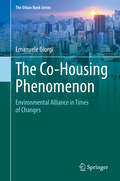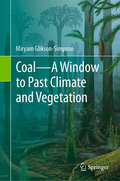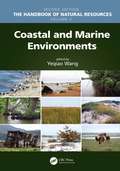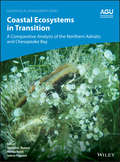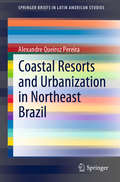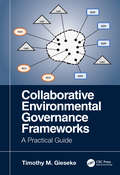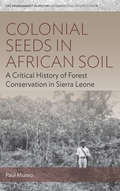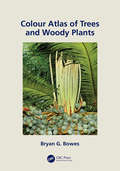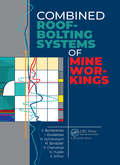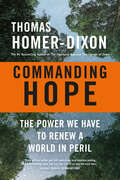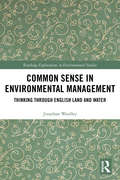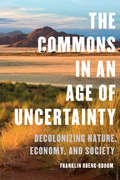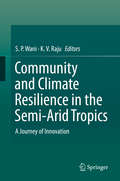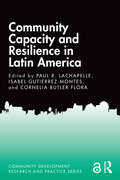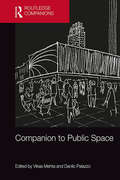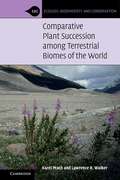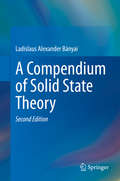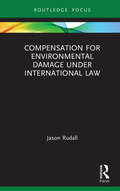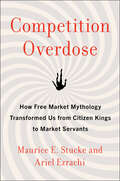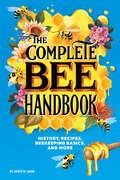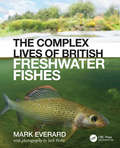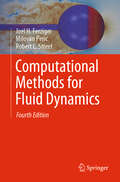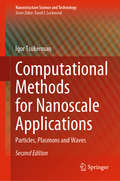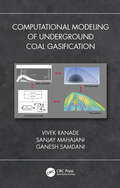- Table View
- List View
The Co-Housing Phenomenon: Environmental Alliance in Times of Changes (The Urban Book Series)
by Emanuele GiorgiThis book presents 50 case studies of contemporary co-housing projects spread all over the world to show how communities of shared living have become a global phenomenon that can serve as a tool to promote social and urban sustainability. By presenting evidence that shared housing experiences are capable of revitalizing sterile urban fabrics and promoting social sustainable practices, the volume situates co-housing experiences as microscale responses to the macroscale challenges posed by environmental degradation and the decline of communitarian ways of living.The volume also reviews the most famous typologies of shared living in different parts of the world across human history. By analyzing historical experiences in different regions of Africa, Americas, Asia, Europe and Oceania, the author shows that living together is part of a historical culture of sharing that is being rediscovered all over the world by people who activate public spaces, work in shared offices or live in contractual communities. The Co-Housing Phenomenon – Environmental Alliance in Times of Changes will be of interest to both professionals and scholars involved in urban design, urban planning and architecture, especially those in the field of sustainable urbanism. It will also be a valuable resource for public agents and civil society organizations dealing with housing, social, environmental and sustainability policies.
Coal—A Window to Past Climate and Vegetation
by Miryam Glikson-SimpsonThis book focuses on the Permian time slice in the geological history of Gondwana, which includes Australia, India, South Africa, Antarctica and South America. Coal is an organic rock, the product of compressed and ‘cooked’ plants. The exact formation of coal via physicochemical reactions, burial and subsidence is the subject of numerous books. The vast thick coal deposits characterising Gondwana formed from special kind of trees termed the Glossopteris Flora. These trees shed their leaves in winter and with the rest of their remains decayed and through subsidence and burial formed the coal. Pollen preserved from these plant communities has been concentrated and isolated and is the focus of this book. The first plant communities as can be seen from the pollen graphs in this book were impoverished in species. The Permian era started with a very cold climate and as the climate warmed more and more diverse vegetation took hold. The emergence of different forms of pollen at certain times in the Permian is used as an indicator of climatic change. Furthermore, the predominance of algal spores in some samples and lack of representation by pollen of Glossopteris point to significant changes in the climate which led to the disappearance of their pollen and the accumulation of spores representing algal communities. These climate induced changes are noticed in their completed transformation after a long time span; small changes are evident during a lifetime of Earth’s inhabitants. Today, in our lifetime, we can see and witness the drying of many lakes across the Earth and their total disappearance from maps of only 50 years ago is a testimony to a climatic change taking place. The time of a ‘complete’ change in the Permian is possible to calculate. However, to determine the duration and maximum change in the climate of the earth today is impossible due to the apparent acceleration of the process by industrial activities of our species. Chapter 4 in the book deals with the special characteristics of the Permian coals of Gondwana and the special plant community which made them. The composition of these coals on a microscopic level shows them to be rich in hydrocarbons, more than other coals. The Permian coals of India and Australia generate ‘heavy’ oil which is retained within the coal matrix as bitumen and is a potential source of methane. This chapter demonstrates through a pilot study the potential for explosion in the Permian Gondwana coals through their propensity to spontaneous combustion and methane generation.
Coastal and Marine Environments
by Yeqiao WangAuthored by world-class scientists and scholars, The Handbook of Natural Resources, Second Edition, is an excellent reference for understanding the consequences of changing natural resources to the degradation of ecological integrity and the sustainability of life. Based on the content of the bestselling and CHOICE-awarded Encyclopedia of Natural Resources, this new edition demonstrates the major challenges that the society is facing for the sustainability of all well-being on the planet Earth. The experience, evidence, methods, and models used in studying natural resources are presented in six stand-alone volumes, arranged along the main systems of land, water, and air. It reviews state-of-the-art knowledge, highlights advances made in different areas, and provides guidance for the appropriate use of remote sensing and geospatial data with field-based measurements in the study of natural resources. Volume 5, Coastal and Marine Environments, discusses marine and coastal ecosystems, their biodiversity, conservation, and integrated marine management plans. It provides fundamental information on coastal and estuarine systems and includes discussions on coastal erosion and shoreline change, natural disasters, evaporation and energy balance, fisheries and marine resource management, and more. New in this edition are discussions on sea level rise, renewable energy, coral reef restoration, fishery resource economics, and coastal remote sensing. This volume demonstrates the key processes, methods, and models used through many case studies from around the world. Written in an easy-to-reference manner, The Handbook of Natural Resources, Second Edition, as individual volumes or as a complete set, is an essential reading for anyone looking for a deeper understanding of the science and management of natural resources. Public and private libraries, educational and research institutions, scientists, scholars, and resource managers will benefit enormously from this set. Individual volumes and chapters can also be used in a wide variety of both graduate and undergraduate courses in environmental science and natural science at different levels and disciplines, such as biology, geography, earth system science, and ecology.
Coastal Ecosystems in Transition: A Comparative Analysis of the Northern Adriatic and Chesapeake Bay (Geophysical Monograph Series #256)
by Thomas C. Malone Alenka Malej Jadran FaganeliExplores how two coastal ecosystems are responding to the pressures of human expansion The Northern Adriatic Sea, a continental shelf ecosystem in the Northeast Mediterranean Sea, and the Chesapeake Bay, a major estuary of the mid-Atlantic coast of the United States, are semi-enclosed, river-dominated ecosystems with urbanized watersheds that support extensive industrial agriculture. Coastal Ecosystems in Transition: A Comparative Analysis of the Northern Adriatic and Chesapeake Bay presents an update of a study published two decades ago. Revisiting these two ecosystems provides an opportunity to assess changing anthropogenic pressures in the context of global climate change. The new insights can be used to inform ecosystem-based approaches to sustainable development of coastal environments. Volume highlights include: Effects of nutrient enrichment and climate-driven changes on critical coastal habitats Patterns of stratification and circulation Food web dynamics from phytoplankton to fish Nutrient cycling, water quality, and harmful algal events Causes and consequences of interannual variability The American Geophysical Union promotes discovery in Earth and space science for the benefit of humanity. Its publications disseminate scientific knowledge and provide resources for researchers, students, and professionals.
Coastal Resorts and Urbanization in Northeast Brazil (SpringerBriefs in Latin American Studies)
by Alexandre Queiroz PereiraThis book intends to present the development of socio-spatial practices in the metropolitan coast of the Northeast of Brazil, highlighting the main urban, spa and tourist agglomerations: Salvador-BA, Recife-PE, Fortaleza-CE, and Natal-RN. The objective is to study the processes of urbanization associated with maritime leisure. In the first chapter, the reader will find a historical and conceptual presentation highlighting the relevance of leisure practices, their forms-flows and their role in the formation of maritime resorts. The second chapter analyses the context of the northeastern region of Brazil and demonstrates the process of modernization and formation of the seaside function within the cities, and later, in the maritime metropolises of the region. The relationship between urbanization and touristic real estate ventures is the central theme of the third chapter, which proposes a specific methodology for studies of this nature. The final chapter presents the seaside resorts in the metropolitan area of Fortaleza, a case study similar to others in the Northeast, examining the urbanistic effects and the key ideas of the planners.
Collaborative Environmental Governance Frameworks: A Practical Guide
by Timothy GiesekeThis book takes a practical approach to understanding and describing collaborative governance for resolving environmental problems. It introduces a new collaborative governance assessment model and recognizes that collaborations are a natural result of organizations converging around complex issues. Rather than identifying actors by their type of organization, the actors are identified by the type of role they play. This approach is aligned with how individuals and organizations interact in practice, and their dependance on collaborations to solve emerging environmental problems. The book discusses real cases with governance issues and creates new frameworks for collaborations. Features: Addresses communities at all levels and scales that are gravitating toward collaborations to solve their environmental issues. Prepares and enables individuals to participate in collaborative governance and design collaborative governance frameworks. Introduces the first simplified and standardized model to assess governance using governance actors and styles. Explains governance in simple terms and builds governance frameworks from the individual’s perspective; the smallest, viable unit of governance in a collaboration. Describes "tools of convergence" for collaborative leaders to organize and align activities to create shared-governance outcomes and outputs.
Colonial Seeds in African Soil: A Critical History of Forest Conservation in Sierra Leone (Environment in History: International Perspectives #18)
by Paul Munro“Empire forestry”—the broadly shared forest management practice that emerged in the West in the nineteenth century—may have originated in Europe, but it would eventually reshape the landscapes of colonies around the world. Melding the approaches of environmental history and political ecology, Colonial Seeds in African Soil unravels the complex ways this dynamic played out in twentieth-century colonial Sierra Leone. While giving careful attention to topics such as forest reservation and exploitation, the volume moves beyond conservation practices and discourses, attending to the overlapping social, economic, and political contexts that have shaped approaches to forest management over time.
Colour Atlas of Woody Plants and Trees
by Bryan G. BowesTrees and plants are important components of the human environment having significant presence beyond agricultural and recreational values. Colour Atlas of Woody Plants and Trees presents a photographic compilation of morphological features of trees and shrubs giving attention to their unique aspects not presented in existing books. By increasing awareness to users through high quality, full-color photographs and informative text, this book demonstrates the enormous diversity of vascular trees and plants living today. Features: Full color atlas offers concise, but highly informative text accompanied by over 200 high-resolution digital tree images Contains images of the anatomy of tree structures and evolution of the most important features of trees Presents information on the varied structure and morphology exhibited by trees and demonstrates their vital importance in the current struggle for the survival of our human society Surveys the most important morphological features of plants, shrubs and trees Presents aspects of plants and trees both common and rarely seen in nature Bryan Geoffrey Bowes is a retired Senior Lecturer in the Botany Department at Glasgow University and was a Research Fellow in ETH Zurich, Harvard University, and University of New England, Australia. His research interests encompass plant anatomy and ultrastructure, plant regeneration, and morphogenesis in vitro.
Combined Roof-Bolting Systems of Mine Workings
by V. Bondarenko, I. Kovalevska, H. Symanovych, M. Barabash, V. Chervatiuk, O. Husiev and V. SnihurThe basic principles of geomechanical processes occurring in mine workings during the extraction of minerals are discussed in this monograph. Particular attention is paid to the support system, specifically to the various roof-bolt and frame support designs, and also to the modern means providing resource-saving conditions for ensuring mine workings sustainability. The basic principles of the computing experiment performance at the modelling of geomechanical processes are also presented and the stress-strain state of "rock massif – mine working support" systems are investigated. Finally, the results of field studies are discussed and illustrated. Modern studies are presented in this work, the advanced support systems are introduced and the solution to the problem of low-cost rock pressure control in mine workings is described. Further the unique study in the thin-layer massif of weak rocks is conducted and the technical and economic aspects of mine workings maintenance during rocks heaving are described. The book will be of interest to scientists in research and design organizations in the mining sector, engineers and technological workers in mines, as well as university academics and students.
Commanding Hope: The Power We Have to Renew a World in Peril
by Thomas Homer-DixonFrom the #1 BESTSELLING thought leader: Calling on history, cutting-edge research, complexity science and even Lord of the Rings, Thomas Homer-Dixon lays out the tools we can command to rescue a world on the brink.For three decades, the renowned author of The Upside of Down: Catastrophe, Creativity, and the Renewal of Civilization, and The Ingenuity Gap: Can We Solve the Problems of the Future?, has examined the threats to our future security--predicting a deteriorating global environment, extreme economic stresses, mass migrations, social instability and wide political violence if humankind continued on its current course. He was called The Doom Meister, but we now see how prescient he was. Today just about everything we've known and relied on (our natural environment, economy, societies, cultures and institutions) is changing dramatically--too often for the worse. Without radical new approaches, our planet will become unrecognizable as well as poorer, more violent, more authoritarian.In his fascinating long-awaited new book (dedicated to his young children), he calls on his extraordinary knowledge of complexity science, of how societies work and can evolve, and of our capacity to handle threats, to show that we can shift human civilization onto a decisively new path if we mobilize our minds, spirits, imaginations and collective values. Commanding Hope marshals a fascinating, accessible argument for reinvigorating our cognitive strengths and belief systems to affect urgent systemic change, strengthen our economies and cultures, and renew our hope in a positive future for everyone on Earth.
Common Sense in Environmental Management: Thinking Through English Land and Water (Routledge Explorations in Environmental Studies)
by Jonathan WoolleyCommon Sense in Environmental Management examines common sense not in theory, but in practice. Jonathan Woolley argues that common sense as a concept is rooted in English experiences of landscape and land management and examines it ethnographically - unveiling common sense as key to understanding how British nature and public life are transforming in the present day. Common sense encourages English people to tacitly assume that the management of land and other resources should organically converge on a consensus that yields self-evident, practical results. Furthermore, the English then tend to assume that their own position reflects that consensus. Other stakeholders are not seen as having legitimate but distinct expertise and interests – but are rather viewed as being stupid and/or immoral, for ignoring self-evident, pragmatic truths. Compromise is therefore less likely, and land management practices become entrenched and resistant to innovation and improvement. Through a detailed ethnographic study of the Norfolk Broads, this book explores how environmental policy and land management in rural areas could be more effective if a truly common sense was restored in the way we manage our shared environment. Using academic and lay deployments of common sense as a route into the political economy of rural environments, this book will be of great interest to scholars and students of socio-cultural anthropology, sociology, human geography, cultural studies, social history, and the environmental humanities.
The Commons in an Age of Uncertainty: Decolonizing Nature, Economy, and Society
by Franklin Obeng-OdoomIn the last two hundred years, the earth has increasingly become the private property of a few classes, races, transnational corporations, and nations. Repeated claims about the "tragedy of the commons" and the "crisis of capitalism" have done little to explain this concentration of land, encourage solution-building to solve resource depletion, or address our current socio-ecological crisis. The Commons in an Age of Uncertainty presents a new explanation, vision, and action plan based on the idea of commoning the land. The book argues that by commoning the land, rather than privatising it, we can develop the foundation for prosperity without destructive growth and address both local and global challenges. Making the land the most fundamental priority of all commons does not only give hope, it also opens the doors to a new world in which economy, environment, and society are decolonised and liberated.
Community and Climate Resilience in the Semi-Arid Tropics: A Journey of Innovation
by K. V. Raju S. P. WaniThis book focuses on developing an integrated holistic approach for harnessing the potential of rain-fed agriculture. In this approach, rainwater management through harvesting and recharging the groundwater is used as an entry point activity for increasing the productivity for farmers through enhanced water use efficiency. To provide the holistic and integrated solutions, the approach of consortium through building partnerships with different stakeholders, eg. different research institutions (State, National and International), development departments, eg. Department of Agriculture, Department of Animal Husbandry etc., Non-Government Organizations (NGOs), Farmers Organizations Community-based Organizations (CBOs) along with market linkages through private companies.
Community Capacity and Resilience in Latin America (Community Development Research and Practice Series)
by Paul R. Lachapelle Isabel Gutierrez-Montes Cornelia Butler FloraCommunity Capacity and Resilience in Latin America addresses the role of communities in building their capacity to increase resiliency and carry out rural development strategies in Latin America. Resiliency in a community sense is associated with an ability to address stress and respond to shock while obtaining participatory engagement in community assessment, planning and outcome. Although the political contexts for community development have changed dramatically in a number of Latin American countries in recent years, there are growing opportunities and examples of communities working together to address common problems and improve collective quality of life. This book links scholarship that highlights community development praxis using new frameworks to understand the potential for community capacity and resiliency. By rejecting old linear models of development, based on technology transfer and diffusion of technology, many communities in Latin America have built capacity of their capital assets to become more resilient and adapt positively to change. This book is an essential resource for academics and practitioners of rural development, demonstrating that there is much we can learn from the skills of self-diagnosis and building on existing assets to enhance community capitals. Chapter 3 of this book is freely available as a downloadable Open Access PDF at http://www.taylorfrancis.com under a Creative Commons Attribution (CC-BY) 4.0 license.
Community Nutrition Resilience in Greater Miami: Feeding Communities in the Face of Climate Change (Palgrave Studies in Climate Resilient Societies)
by Franziska Alesso-BendischThis book conceptualizes community nutrition resilience as a critical area that is currently lacking the attention it requires from both the public and private sectors. The book spotlights Greater Miami’s resilience efforts, both responding to slowly developing challenges such as immigration, environmental deterioration, and the wealth distribution gap, as well as sudden disasters such as hurricanes or flooding driven by climate change. Drawing on existing literature as well as interviews with professionals working in the field, the author makes recommendations on how to incorporate food systems into urban resilience planning, how to prioritize resilience on urban food agendas, and how to strengthen food system resilience through public, private, and third sector level engagement. She also highlights how the availability of and access to nutritious food impact the health, performance, and well-being of communities in the region, thus making a strong case for the prioritization of this growing issue.
Companion to Public Space
by Vikas MehtaThe Companion to Public Space draws together an outstanding multidisciplinary collection of specially commissioned chapters that offer the state of the art in the intellectual discourse, scholarship, research, and principles of understanding in the construction of public space. Thematically, the volume crosses disciplinary boundaries and traverses territories to address the philosophical, political, legal, planning, design, and management issues in the social construction of public space. The Companion uniquely assembles important voices from diverse fields of philosophy, political science, geography, anthropology, sociology, urban design and planning, architecture, art, and many more, under one cover. It addresses the complete ecology of the topic to expose the interrelated issues, challenges, and opportunities of public space in the twenty-first century. The book is primarily intended for scholars and graduate students for whom it will provide an invaluable and up-to-date guide to current thinking across the range of disciplines that converge in the study of public space. The Companion will also be of use to practitioners and public officials who deal with the planning, design, and management of public spaces.
Comparative Plant Succession among Terrestrial Biomes of the World (Ecology, Biodiversity and Conservation)
by Karel Prach Lawrence R. WalkerDespite a century of study by ecologists, recovery following disturbances (succession) is not fully understood. This book provides the first global synthesis that compares plant succession in all major terrestrial biomes and after all major terrestrial disturbances. It asks critical questions such as: Does succession follow general patterns across biomes and disturbance types? Do factors that control succession differ from biome to biome? If common drivers exist, what are they? Are they abiotic or biotic, or both? The authors provide insights on broad, generalizable patterns that go beyond site-specific studies, and present discussions on factors such as varying temporal dynamics, latitudinal differences, human-caused vs. natural disturbances, and the role of invasive alien species. This book is a must-read for researchers and students in ecology, plant ecology, restoration ecology and conservation biology. It also provides a valuable framework to aid land managers attempting to manipulate successional recovery following increasingly intense and widespread human-made disturbances.
A Compendium of Solid State Theory
by Ladislaus Alexander BányaiDesigned to sit alongside more conventional established condensed matter physics textbooks, this compact volume offers a concise presentation of the principles of solid state theory, ideal for advanced students and researchers requiring an overview or a quick refresher on a specific topic.The book starts from the one-electron theory of solid state physics, moving through electron-electron interaction and many-body approximation schemes, to lattice oscillations and their interactions with electrons. Subsequent chapters discuss transport theory and optical properties, phase transitions and some properties of low-dimensional semiconductors. This extensively expanded second edition includes new material on adiabatic perturbation theory, kinetic coefficients, the Nyquist theorem, Bose condensation, and the field-theoretical approach to non-relativistic quantum electrodynamics. Throughout the text, mathematical proofs are often only sketched, and the final chapter of the book reviews some of the key concepts and formulae used in theoretical physics.Aimed primarily at graduate and advanced undergraduate students taking courses on condensed matter theory, the book serves as a study guide to reinforce concepts learned through conventional solid state texts. Researchers and lecturers will also find it a useful resource as a concise set of notes on fundamental topics.
Compensation for Environmental Damage Under International Law (Routledge Research in International Environmental Law)
by Jason RudallInspired by recent litigation, this book identifies and critically appraises the manifold and varied approaches to calculating compensation for damage caused to the environment. It examines a wide range of practice on compensation – in general and specifically for environmental damage – from that of international courts and tribunals, as well as international commissions and regimes, to municipal approaches and other disciplines such as economics and philosophy. Compensation for Environmental Damage Under International Law synthesises these approaches with a view to identifying their blind spots, bringing clarity to an area where there exists broad discrepancy, and charting best practices that appropriately balance the manifold interests at stake. In particular, it is argued that best practice methodologies should ensure compensation serves to fully repair the environment, reflect the emerging ecosystems approach and any implications environmental damage may have for climate change, as well as take into account relevant equitable considerations. This book is essential reading for academics, practitioners and students working in the field of environmental law.
Competition Overdose: How Free Market Mythology Transformed Us from Citizen Kings to Market Servants
by Maurice E. Stucke Ariel EzrachiStucke and Ezrachi’s analysis of the nature of competition is refreshingly non-ideological and counterintuitive. Their idea that competition can be either toxic or noble—all depending on how governments structure markets—is something so clear that it’s remarkable it’s taken us decades to recognize the wisdom of it. This is a must-read for anyone interested in how to use public policy to harness the competitive drive for the public good. — Chris Hughes, cofounder of FacebookStucke and Ezrachi show us the important differences between destructive and noble competition and what we can do to pursue a more just and prosperous world. This book changes how you will view the role of the market in our economy and society at large. — Spencer Weber Waller, director of the Institute for Consumer Antitrust Studies and law professor at Loyola University ChicagoEntertaining and thought-provoking, Competition Overdose fiercely articulates the raw, hard truth behind the toxic aspects of competition. — Tommaso Valletti, professor of economics at Imperial College London and Chief Competition Economist (2016–2019), European CommissionCompetition Overdose is probably the most important book to be published on the subject since The Antitrust Paradox hit the bookshelves in 1978. It is destined to transform how governments across the world think about the role competition in domestic and international policy for decades to come. Stucke and Ezrachi are the new rock stars of competition policy. — Ali Nikpay, partner at Gibson Dunn & CrutcherAnything, in the wrong dosage, can be poisonous. Competition Overdose takes a sacred cow of contemporary western thought—that ‘more competition is always good’—and reveals that while competition can be noble, it can also be toxic. An engaging and compelling read that will make you think differently about situations we all deal with every day. — Tim Wu, professor at Columbia Law School, contributing opinion writer for the New York Times, and author of The Master Switch and The Attention MerchantsA must-read for anyone concerned about the future of our economy and society, Competition Overdose provides a no-nonsense analysis of how toxic competition can be bad for competitors, consumers, workers, and society overall. The authors highlight the abuses of this ideology and remind us that we, as citizens and consumers, can exercise our power by choosing products, based on our values. — Monique Goyens, director general of BEUC, The European Consumer OrganisationThis beautifully written book helps us rethink economic principles from the ground up. As any good chemist knows, what can be helpful or harmless in small doses is deadly in excess. While technocrats push competition as a cure to all economic ailments, Stucke and Ezrachi deliver a dose of reality: cutthroat schemes to kneecap rivals, manipulate customers, and exploit workers harm far more than they help. Read this book for a brilliant account of the proper place of competition (and ethics) in society. — Frank Pasquale, law professor at University of Maryland and author of The Black Box SocietyStucke and Ezrachi examine a multitude of perversities in today’s society—colleges striving to recruit applicants they likely will reject, supermarkets stocking hundreds of varieties of jam, travel deals stuffed with hidden fees—and provide a unifying explanation: a misalignment of competition. Their book illuminates how competition can go wrong, and how individuals, businesses, and the government can set it right. — Jonathan Levin, dean of Stanford Graduate School of BusinessIs more competition the solution to all our societal problems? Stucke and Ezrachi persuasively say: No, it depends; sometimes we need to rein in markets because they prod
The Complete Bee Handbook: History, Recipes, Beekeeping Basics, and More
by Dewey M. CaronA guide to the history, behavior, and bounty of the humble bee From backyard keeping to bee-centric foods and home goods, there's no end to humankind's fascination with bees. The Complete Bee Handbook is a compelling read and easy-to-use reference, packed with practical and thought-provoking information for bee lovers new and old. Journey through the past, present, and future of the bee, including their evolution, their ever-critical role as pollinators, and the ongoing threats that jeopardize their survival. You'll also discover a short and sweet cultural history of beekeeping, the numerous applications of bee products, and tips on how you can support your local bee population. This bee guide explores: The life of the honey bee—Look into the mind of the hive as you learn about the role each bee plays in helping their colony function and thrive. Beekeeping for beginners—Get simple advice for cultivating a bee-friendly garden, from preferred plants to fun DIY accessories. Buzzworthy recipes—Try your hand at creative recipes for bee lovers, including mead, baklava, beeswax soap, and candles. Discover everything you wanted to know about bees with The Complete Bee Handbook!
The Complex Lives of British Freshwater Fishes
by Mark EverardThis stunningly illustrated book goes far beyond a run-of-the-mill nature guide. It explores the fascinating life histories of Britain’s freshwater fishes, a group of animals which, despite their importance and ubiquity in our diverse still and flowing fresh waters, has before now been rarely regarded and respected as 'wildlife'. Our native fishes tend generally to be considered as simply something for anglers to catch or for people to eat, yet they work enormously hard for us. Author Mark Everard, avid nature-watcher, angler and scientist, shows how freshwater fish provide food, ornamentation, sport and cultural identity, and highlights their huge importance for conservation as part of the living ecosystems upon which we all depend. He dives into the mysteries moving below the surface of our rivers and lakes, bringing the wonderful and fascinating world of the diversity of British freshwater fish species into plain sight and into mind. This unique book features over 100 full-colour photographs by pioneering photographer and filmmaker Jack Perks, whose work has featured on BBC Springwatch, The One Show and Countryfile. The book is filled with technical detail useful to conservationists and biology students. Most importantly, it is also presented in an accessible, visually attractive and engaging manner that will appeal to anybody with an interest in the natural world: the conservation-minded public, the angling community, and our nation of wildlife enthusiasts. Whatever your background, this book will open your eyes to our freshwater fishy wealth, and the many ways in which it enriches our lives.
Computational Methods for Fluid Dynamics
by Joel H. Ferziger Milovan Perić Robert L. StreetThis book is a guide to numerical methods for solving fluid dynamics problems. The most widely used discretization and solution methods, which are also found in most commercial CFD-programs, are described in detail. Some advanced topics, like moving grids, simulation of turbulence, computation of free-surface flows, multigrid methods and parallel computing, are also covered. Since CFD is a very broad field, we provide fundamental methods and ideas, with some illustrative examples, upon which more advanced techniques are built. Numerical accuracy and estimation of errors are important aspects and are discussed in many examples. Computer codes that include many of the methods described in the book can be obtained online. This 4th edition includes major revision of all chapters; some new methods are described and references to more recent publications with new approaches are included. Former Chapter 7 on solution of the Navier-Stokes equations has been split into two Chapters to allow for a more detailed description of several variants of the Fractional Step Method and a comparison with SIMPLE-like approaches. In Chapters 7 to 13, most examples have been replaced or recomputed, and hints regarding practical applications are made. Several new sections have been added, to cover, e.g., immersed-boundary methods, overset grids methods, fluid-structure interaction and conjugate heat transfer.
Computational Methods for Nanoscale Applications: Particles, Plasmons and Waves (Nanostructure Science and Technology)
by Igor TsukermanPositioning itself at the common boundaries of several disciplines, this work provides new perspectives on modern nanoscale problems where fundamental science meets technology and computer modeling. In addition to well-known computational techniques such as finite-difference schemes and Ewald summation, the book presents a new finite-difference calculus of Flexible Local Approximation Methods (FLAME) that qualitatively improves the numerical accuracy in a variety of problems.
Computational Modeling of Underground Coal Gasification
by Vivek V. Ranade Sanjay M Mahajani Ganesh Arunkumar SamdaniThe book deals with development of comprehensive computational models for simulating underground coal gasification (UCG). It starts with an introduction to the UCG process and process modelling inputs in the form of reaction kinetics, flow patterns, spalling rate, and transport coefficient that are elaborated with methods to generate the same are described with illustrations. All the known process models are reviewed, and relative merits and limitations of the modeling approaches are highlighted and compared. The book describes all the necessary steps required to determine the techno-economic feasibility of UCG process for a given coal reserve, through modeling and simulation.
